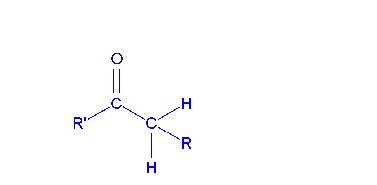show what esters would undergo claisen condensation to give the following β-keto esters.
| Claisen condensation | |
|---|---|
| Named subsequently | Rainer Ludwig Claisen |
| Reaction type | Coupling reaction |
| Identifiers | |
| Organic Chemistry Portal | claisen-condensation |
| RSC ontology ID | RXNO:0000043 |
The Claisen condensation is a carbon–carbon bond forming reaction that occurs between two esters or one ester and another carbonyl compound in the presence of a potent base, resulting in a β-keto ester or a β-diketone.[1] It is named later on Rainer Ludwig Claisen, who first published his work on the reaction in 1887.[ii] [3] [4]

Requirements [edit]
At to the lowest degree one of the reagents must be enolizable (have an α-proton and exist able to undergo deprotonation to class the enolate anion). There are a number of unlike combinations of enolizable and nonenolizable carbonyl compounds that form a few different types of Claisen.
The base of operations used must not interfere with the reaction by undergoing nucleophilic substitution or addition with a carbonyl carbon. For this reason, the conjugate sodium alkoxide base of the alcohol formed (due east.g. sodium ethoxide if ethanol is formed) is frequently used, since the alkoxide is regenerated. In mixed Claisen condensations, a non-nucleophilic base such equally lithium diisopropylamide, or LDA, may be used, since only one chemical compound is enolizable. LDA is not commonly used in the classic Claisen or Dieckmann condensations due to enolization of the electrophilic ester.
The alkoxy portion of the ester must be a relatively expert leaving group. Methyl and ethyl esters, which yields methoxide and ethoxide, respectively, are normally used.
Types [edit]
- The classic Claisen condensation, a self-condensation between ii molecules of a compound containing an enolizable ester.
- The mixed (or "crossed") Claisen condensation, where i enolizable ester or ketone and one nonenolizable ester are used.
- The Dieckmann condensation, where a molecule with 2 ester groups reacts intramolecularly, forming a cyclic β-keto ester. In this case, the ring formed must not exist strained, usually a v- or vi-membered chain or ring.
Mechanism [edit]

In the starting time step of the machinery, an α-proton is removed by a strong base of operations, resulting in the formation of an enolate anion, which is made relatively stable by the delocalization of electrons. Next, the carbonyl carbon of the (other) ester is nucleophilically attacked by the enolate anion. The alkoxy group is and so eliminated (resulting in (re)generation of the alkoxide), and the alkoxide removes the newly formed doubly α-proton to form a new, highly resonance-stabilized enolate anion. Aqueous acid (e.g. sulfuric acid or phosphoric acid) is added in the final step to neutralize the enolate and whatsoever base still present. The newly formed β-keto ester or β-diketone is so isolated. Annotation that the reaction requires a stoichiometric amount of base as the removal of the doubly α-proton thermodynamically drives the otherwise endergonic reaction. That is, Claisen condensation does non piece of work with substrates having only one α-hydrogen because of the driving force effect of deprotonation of the β-keto ester in the last footstep.
 |
| animation |
Stobbe condensation [edit]
The Stobbe condensation [five] is a modification specific for the diethyl ester of succinic acid requiring less stiff bases.[6] An example is its reaction with benzophenone:[seven]
A reaction mechanism that explains the formation of both an ester group and a carboxylic acid group is centered on a lactone intermediate (5):
The Stobbe condensation was used in the showtime footstep of Reinhard Sarges' synthesis of tametraline[8] and information technology can also be used in the synthesis of dimefadane.[ commendation needed ]
See too [edit]
- Aldol condensation
- Fatty acid synthesis
- Polyketide synthase
- Dieckmann condensation
References [edit]
- ^ Carey, F. A. (2006). Organic Chemistry (6th ed.). New York, NY: McGraw-Hill. ISBN0-07-111562-5.
- ^ Claisen, L.; Claparede, A. (1881). "Condensationen von Ketonen mit Aldehyden". Berichte der Deutschen Chemischen Gesellschaft. fourteen (2): 2460–2468. doi:ten.1002/cber.188101402192.
- ^ Claisen, L. (1887). "Ueber die Einführung von Säureradicalen in Ketone". Berichte der Deutschen Chemischen Gesellschaft. 20 (1): 655–657. doi:x.1002/cber.188702001150.
- ^ Hauser, C. R.; Hudson, B. Eastward. Jr. (1942). "The Acetoacetic Ester Condensation and Sure Related Reactions". Organic Reactions. ane: 266–302. doi:x.1002/0471264180.or001.09. ISBN0471264180.
- ^ Stobbe, H. (1899). "Condensation des Benzophenons mit Bernsteinsäureester". Justus Liebigs Annalen der Chemie. 308 (i–two): 89–114. doi:10.1002/jlac.18993080106.
- ^ March, Jerry (1985), Advanced Organic Chemistry: Reactions, Mechanisms, and Structure (3rd ed.), New York: Wiley, ISBN0-471-85472-seven
- ^ Johnson, W. Due south.; Schneider, W. P. (1950). "β-CARBETHOXY-γ,γ-DIPHENYLVINYLACETIC ACID" (PDF). Organic Syntheses. 30: 18. ; Commonage Book, vol. 4, p. 132
- ^ Sarges R (1975). "Synthesis of phenyl-substituted one-aminotetralines". The Journal of Organic Chemistry. xl (9): 1216–1224. doi:10.1021/jo00897a008.
External links [edit]
- "Claisen Condensation". Organic Chemistry Portal.
labrecquewhice1982.blogspot.com
Source: https://en.wikipedia.org/wiki/Claisen_condensation





0 Response to "show what esters would undergo claisen condensation to give the following β-keto esters."
Postar um comentário